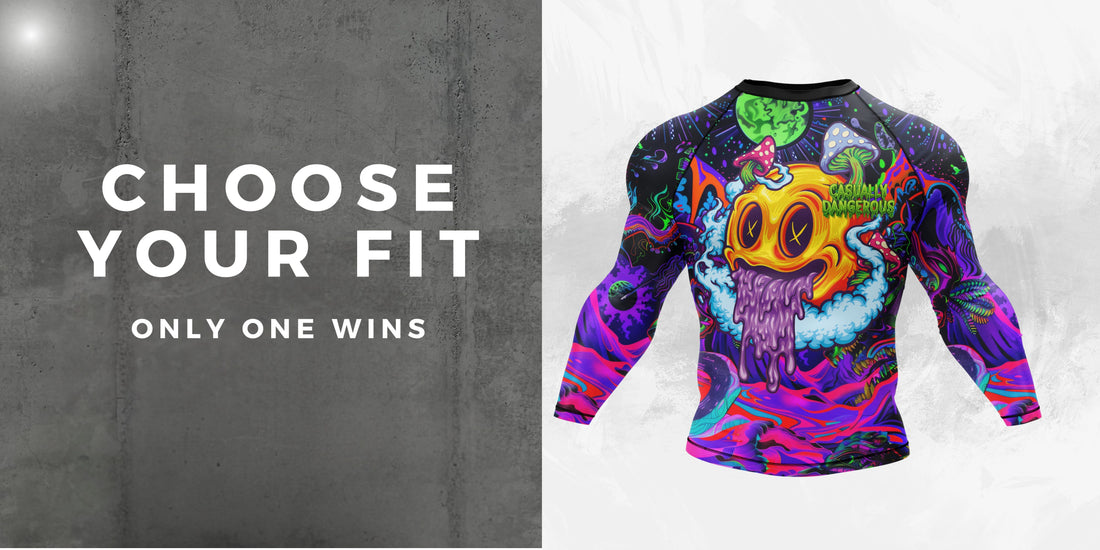
Rash Guard vs Compression Shirt: What’s Best for BJJ?
Share
When I first started Brazilian Jiu-Jitsu, I was all in—but clueless. Like a lot of guys new to the sport, I didn’t want to overthink gear. I figured if I had a mouthguard, some shorts, and something tight to train in, I was good to go.
So I grabbed one of my old compression shirts from my gym bag. I’d used it for lifting, running, and HIIT training. It was snug, sweat-wicking, and looked the part. But once I actually hit the mats for live rolls, I realized fast that it wasn’t going to cut it.
If you’re stuck on the rash guard vs compression shirt question and trying to figure out what’s actually best for BJJ, I’ve lived it—and I’ve got your answer. They might look similar, but only one is built for real grappling.
My First Experience Rolling in a Compression Shirt
That first week of training, I felt fired up. I didn’t care that I wasn’t wearing “official” BJJ gear. I was just excited to be on the mats. But once class moved from drilling to sparring, that compression shirt turned into a problem.
The shirt wouldn’t stay in place. I had to keep tugging it down between rounds. By the end of the night, the seam under my arm had started to unravel. I got a nasty patch of mat burn across my ribs, and the shirt was soaked through in sweat that didn’t evaporate like it should.
At first, I thought maybe I just had a bad one. But the same thing happened with the second shirt. And the third. That’s when I finally realized: compression shirts aren’t made for this. They’re made for clean, controlled workouts—not for the chaos of Jiu-Jitsu.
Here’s Why Compression Shirts Fall Short in BJJ
Compression shirts might check a couple of boxes—tight fit, sweat-wicking fabric—but that’s about it. Once you introduce the friction, twisting, pressure, and grip fighting that comes with no-gi Jiu-Jitsu, they start to fall apart.
Here’s what I dealt with:
-
Shifting and riding up every time I bridged or rolled
-
Seams tearing under pressure, especially around the arms and shoulders
-
Zero protection against skin infections or mat burn
-
No waistband grip, so it would bunch up during scrambles
-
Not IBJJF legal—so it’s a no-go for comps too
You don’t notice these things when you’re bench pressing. But the mat exposes weak gear fast.
Switching to a Real Rash Guard: Game-Changer
Once I switched to an actual BJJ rash guard, the difference was massive. No more pulling my shirt down mid-roll. No more raw skin from the mat. No more popping seams or wet, saggy fabric clinging to me.
What makes rash guards better?
-
Flatlock stitching that won’t dig in or split
-
Strong compression fabric that moves with you but doesn’t stretch out
-
Moisture-wicking and quick-drying, even during intense rolls
-
Antimicrobial treatment to reduce the risk of staph, ringworm, and mat funk
-
Made specifically for grappling—designed to handle grabs, torque, and sweat
Rash guards are built to perform under pressure. They’re engineered for durability, mobility, and hygiene. Honestly, once I wore one, I never rolled without it again.
Check out the kind I use here:
👉 Rash Guards Built for Brazilian Jiu-Jitsu
Rash Guard vs Compression Shirt: What’s Best for BJJ?
Let’s settle the debate. Compression shirts might work fine in the gym, but the moment you hit the mats, you’ll wish you had a rash guard. Whether you’re drilling technique, rolling live, or competing, your gear should move with you, not against you.
Compression shirts:
-
Built for lifting, not grappling
-
Can’t take the wear and tear of rolls
-
Tend to shift, sag, or stretch out
-
Offer little to no skin protection
-
Aren’t legal in most competitions
Rash guards:
-
Built specifically for Jiu-Jitsu
-
Stay locked in through tough rounds
-
Hold their shape over time
-
Protect your skin from friction and bacteria
-
Legal for IBJJF and other tournaments
If you’re serious about training, there’s no comparison. In the rash guard vs compression shirt debate, rash guards win across the board.
Where I Buy My Rash Guards
After going through a few brands, I landed on BJJSESH. What I like most is the balance of comfort and toughness. They fit close without feeling stiff, they last through heavy use, and they look clean—no goofy graphics or overdone designs.
Plus, they pair perfectly with BJJ spats shorts, so if you’re training no-gi, you can put together a full kit that actually moves with your body and doesn’t fall apart in a scramble.
When your training gets more intense, your gear needs to hold up. BJJ isn’t just cardio—it’s pressure, leverage, sweat, and sometimes blood. Wearing the right gear is part of respecting the process and protecting your body.
Final Thoughts
I wasted time (and money) rolling in compression shirts that weren’t meant for this sport. And every session, I paid the price—discomfort, ripped seams, and raw skin. When I finally made the switch to real rash guards, everything changed. I trained better. I felt more confident. I could focus on technique instead of fixing my gear.
If you’re starting your BJJ journey or finally investing in better gear, don’t second-guess it. You’re not just paying for style—you’re paying for performance, durability, and protection.